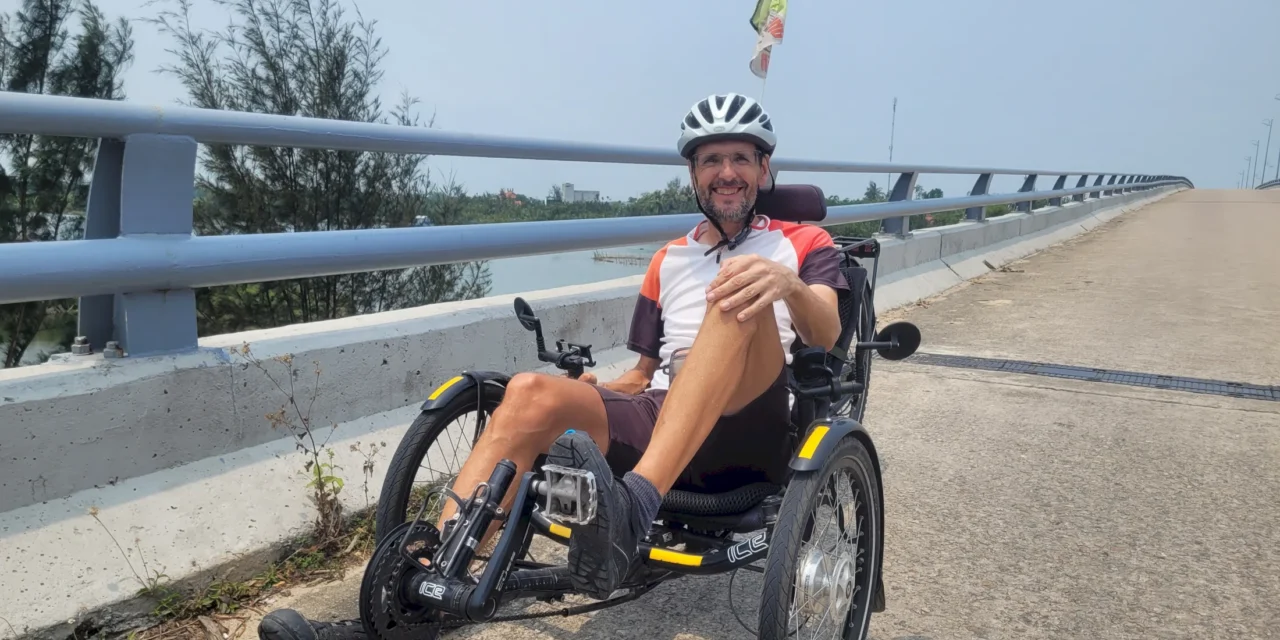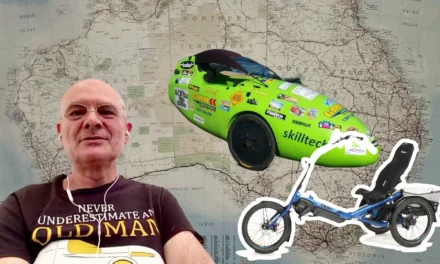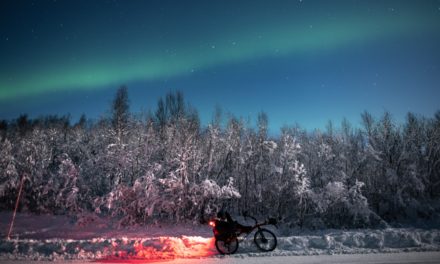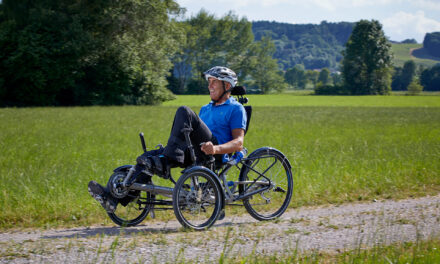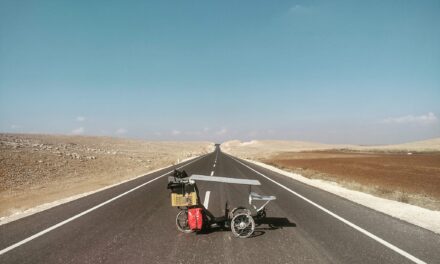Henk’s recumbent trike journey is about more than just cycling; it’s about finding harmony between adventure and art. From crossing Europe to exploring the streets of Southeast Asia, his travels are an incredible mix of cycling, music, and cultural exchange. With a guitar strapped to the side of his trike, Henk connects with locals, fellow travelers, and musicians, creating unforgettable experiences wherever he goes. Henk recently celebrated 1 year of recumbent touring. Congratulations Henk!
Henk Malyster
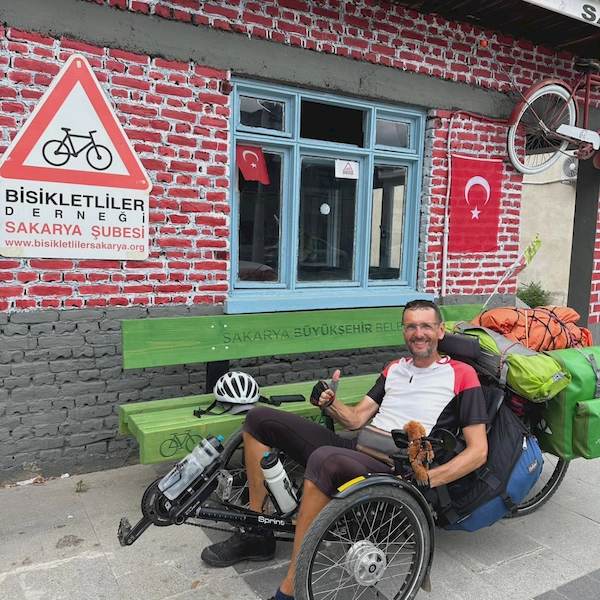
Year of Birth: 1971
Residence: Belgium
Education: College degree-Communication/Journalism
Job: NA
Bike(s): Ice recumbent Trike, Koga Miata Terraliner
Motto: Work less, live more
Website/socials: Instagram 6 String Rider
What made you want to ride a trike around the world? Any previous recumbent experience?
I bought my trike seven years ago after a six week trip in Germany. I was riding my trusty bicycle back then. Since my teenage years I’ve had some persistent neck and back issues and they were playing up again. Despite core stability training, yoga and a bike fit, my back still would lock up mid-trip.
Then, I met this German traveler on a trike. I got intrigued and asked him all about his unusual ride. He told me he used to battle similar back woes, that completely disappeared after switching to life on three wheels. It got me thinking and a few test rides in Belgium later, I found myself the proud owner of a second-hand trike from England. It was love at first… ride. Anyway, I was hooked and immediately started dreaming of a longer adventure.
And then COVID hit. Yet, I was undeterred and in August 2020, I waved goodbye to Belgium and headed towards Portugal. After three months of riding through France and Spain I arrived in Faro. Just as Portugal was locking down, I hopped on a plane to the Canary Islands. I spent a couple of weeks cycling in Grand Canaria, Fuerte Ventura and Lanzarote. Eventually, getting stuck in lockdown in Lanzarote. There are worse places of course, mind you. I ended up spending 14 months in lockdown on the island, I know, tough ordeal!
I was pretty pleased with my first test run. Turned out the slow trike pace was quite my thing. I had also brought my guitar with me, just to find out if it was practical or not. It was a great decision! Nothing beats a jam session with fellow musicians inviting me into their homes (without a mask), or just playing by myself.
During my extended stay on Lanzarote the seed of a longer trip was planted. If I enjoyed three months on the road so much, why not take it further? Of course I first needed to get my budget sorted out. I went back to Belgium and it took a year and a half of diligent saving. Meanwhile, I was physically prepping myself with rigorous training while also buying all the necessary gear for my endeavor. The idea for a world trip only started to grow once I had left last year in May. Going back to Belgium after a mere three months felt… wrong. The only logical direction, clearly, was to continue east.
How long have you been out touring on your trike? How many KM travelled so far, and what countries have you visited?
My current trip began in mid-May 2024. Leaving Belgium, I headed towards Istanbul, Turkey as my first major destination. My route first took me through France. Though, about a week into the ride, I encountered technical issues and had to wait two weeks for spare parts to arrive. Once resolved, I continued into Germany, mostly following the scenic EuroVelo 6 route.
My path then took me through Austria, Hungary, Slovakia, Romania, and Bulgaria, before finally reaching Turkey. While I had to make a few detours to avoid particularly mountainous regions, I arrived in Istanbul after four months on the road, having covered almost 3,800 kilometers.
After a well-deserved break in Istanbul, I set my sights on Tbilisi, Georgia. This leg of the journey mostly followed the Black Sea coast, with occasional inland stretches through Turkey. It took another month and a half to reach the Georgian capital, adding an extra 1,600 kilometers to the tally, bringing the total to 5,600 km. By this point, it was late October, and autumn was kicking in hard now – less than ideal for me.
At a certain moment I had flirted with the idea of cycling through Iran, but the prospect of the cold (I really hate it) prompted a change of plans in favour of a warmer climate. So, I got a plane ticket from Tbilisi to Phuket, Thailand – surprisingly, it was the most budget-friendly flight option. From there, I covered a significant distance within Thailand, heading north to Phitsanulok before turning southeast towards Cambodia.
From the beginning of November until the end of February, I continued my exploration through Thailand, Cambodia, and Vietnam. By the time I decided to take a break in the charming coastal village of An Bang, near Da Nang, I had been on the road for eight months and had clocked up 10,000 kilometers.
Firstly, the added weight is significant; the guitar itself is around 3.5 kg,
the case adds another 2.5 kg.
You did not want to leave home without your full size guitar, what kind of guitar and how do you pack/protect it on the trike?
Having played guitar for over 30 years, I quickly realized that bringing an electric guitar on a bicycle trip could be cumbersome. Lugging around an amp is really impractical; never mind the weight. Remembering how much I missed playing during my trip to Germany, I vowed never to embark on a journey again without a six-string companion.
I did consider travel guitars – the kind with detachable necks or smaller bodies – but the sound often left much to be desired, ranging from boxy to just plain awful. Plus, many decent ones were too expensive to risk on a long, unpredictable adventure. The thought of opening the case to find my guitar with a broken neck was enough to bring tears to my eyes.
Ultimately, I chose my current guitar for its slim body, making it a bit smaller and lighter than a standard folk guitar. It’s a French brand called Lag, and the sound is quite good for its size. The glossy black finish is a real head-turner. Whenever I take it out, fellow guitar players want to lay their hands on it. I’m not a jealous type, by the way!
I invested in a matching case that offers a good balance between a soft and hard case. It’s well-padded and sturdy enough to handle everyday bumps, though I wouldn’t want to test it against a car! I also have a custom-made rain cover that not only protects it from the elements but also helps keep the dust at bay. Interestingly, the rain cover has an added bonus: it does a surprisingly good job of saving my instrument from any unwanted aromatic surprises left behind by feline friends who clearly have no shame peeing all over it.
Securing the guitar to my trike involves a long lock and several straps, positioned on the right-hand side. The neck tucks neatly beneath the seat, and the body rests alongside the back wheel, sticking out by only about twenty centimeters. I absolutely love this guitar, and it still amazes me every time I take it out of the case – it stays perfectly in tune! This is despite the constant vibrations, temperature fluctuations, and humidity changes. I suspect the double layer of protection – the rain cover and the padded case – helps to maintain relatively stable conditions, even though it does soak up a fair bit of heat when the sun is blazing.
Of course, there are a couple of downsides to this setup. Firstly, the added weight is significant; the guitar itself is around 3.5 kg, and the case adds another 2.5 kg. But hey, anything for art! It also takes extra time to secure everything, the rain cover occasionally gets covered by chain grease (requiring careful maneuvering to avoid getting caught in it), and the guitar does catch its fair share of wind. While I don’t notice it too much while cycling, I have to be extra cautious when parking on a windy day.
This was unfortunately proven when a strong gust in Vietnam toppled my trike upside down. Damage? A broken flag pole, a damaged mirror, and a guitar case that now has a slightly less-than-perfect form. And the guitar itself? Not a single scratch and still perfectly in tune! A testament to its resilience, or perhaps just plain luck.
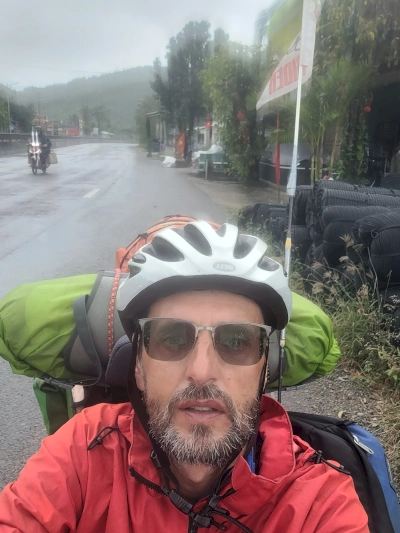
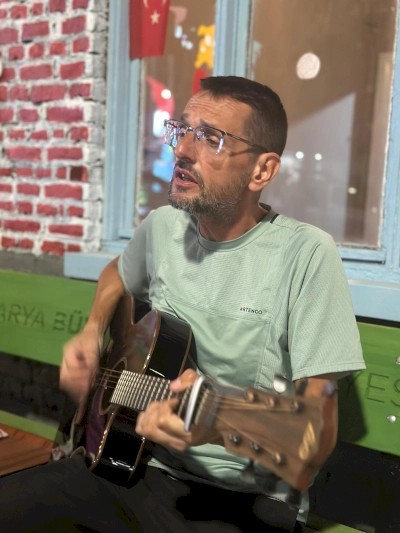
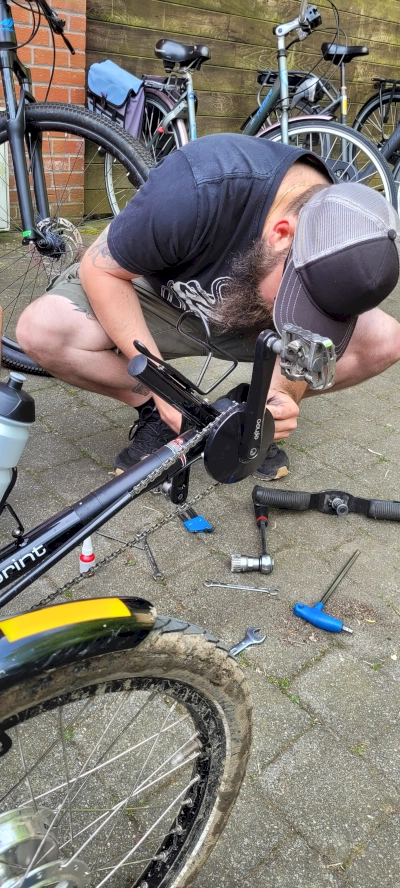
Do you play every day?
I try to play almost every day, their is a specific routine of musical exercises that I’ve been doing since I started learning. I have a repertoire of about 50 cover songs, alongside another list of tunes I’m currently learning. Singing and playing simultaneously is a relatively recent skill for me – I’ve only been doing it for about five years – and I’m still on a quest to find the perfect key for my voice. It’s an ongoing exploration, and I try to maintain a daily practice because I know consistency is the best way to improvement.
Some days, my playing is more casual; I might just noodle around on the guitar for fun or play along with songs to figure out chords or song structures. I used to compose my own music, but that’s taken a backseat for a while. Perhaps I’ll revisit it one day.
The duration of my playing sessions varies. Some days it’s just a brief 10-15 minutes, while other times, once I get into it, hours seem to melt away. Two or three-hour sessions are not uncommon. Every now and then, I even find myself in a sort of trance. I forget about space and time, and I’m so into the music that I forget I’m the one playing. It’s a purely musical experience, not a spiritual one. These moments, though rare and fleeting, are quite special. I’m usually brought back to reality by the rather unpleasant sensation of a sore backside from sitting in the same position for too long!
For me, life is music. And while I aim for daily practice, there are days when I don’t play at all, and that’s perfectly fine. My guitar is always within sight or easy reach. I simply love having it nearby, even just to look at.
Best Jam session so far while on tour?
Without a doubt, my best jam session so far was a ten-minute soundscape in Tiki Garden, Kampot, Cambodia. It was at an open mic night hosted by the French owner, Jean-François, who was laying down a steady groove on percussion. The resident guitar player, Cris was the master of ceremony, flanked by Campbell, a lead guitarist from Scotland, myself and then there was Mary, a French musician, enchanting us all with the ethereal sounds of her handpan. The harmonics that emerged from this quintet were simply wonderful.
We started by feeling out the right key, and then Mary just began to weave in these beautiful, resonant notes on her handpan. As is typical at the beginning of a jam, there’s that phase of musical exploration. As Mary was defining the main melody, Campbell put in some licks and solos, while I provided a mix of chords and rhythmic bass lines on my guitar, and Jean-François keeping the beat going.
It often builds from a simple, repetitive foundation. But then, a natural flow takes over. You listen intently to how the collective melody unfolds, you become acutely aware of your own contribution, and you can almost sense when a musical shift is coming and where it’s naturally heading.
We could feel the energy grow, like a wave of sound and vibrations washing over all of us. A subtly increase of tempo, a random note leading the path to explore a new chord progression. You can sense when the musical connection is strong, when everyone is locked in and excited by what’s happening, and sometimes that energy becomes contagious, spilling over to the audience. And that’s exactly what happened during this jam.
The electricity in the air was palpable. I could hear appreciative shouts of ‘yeah!’ from the listeners, and when I looked around, I saw nothing but smiling faces, completely absorbed in the music. Mary, with her handpan, seemed to be the heart of this spontaneous composition; she just had to give a slight nod or a knowing glance to signal an upcoming change or a moment to bring the intensity down.
As someone who doesn’t jam regularly, I normally feel like I’m out of my depths. But during this particular session with Jean-François, Campbell, and Mary, I learned to let go of any self-doubt about not knowing exactly what to play and simply immerse myself in this incredible, shared experience with complete strangers, accepting my role in serving the collective sound. It’s truly remarkable how such a profound connection can form through music.
This is a completely different and liberating mindset compared to the structured approach of performing a rehearsed song. Don’t get me wrong, I love playing songs. At the same time, I’m grateful for having this opportunity to integrate my playing into such a fluid and spontaneous musical conversation. And it wasn’t just me who felt the magic; afterwards, we had this shared recognition that we had collectively created something truly special. It was an unforgettable musical moment I will always cherish.
In the past, I often hesitated, not wanting to feel like I was ‘bothering’ people. Now, a simple ‘hello’ often leads to unexpected and enriching chats. It’s a small change, but one I appreciate.
A full size guitar takes up a good amount of space, what else is on your trike and how do you pack it all?
It’s true my guitar definitely occupies a significant portion of my trike’s real estate. To balance things out, the left side sports a green 25-liter Vaude Aqua Back Plus bike pannier. The extra pocket on the front is really a plus. I put my first-aid-kit there, some bike tools and a wet towels set.
On the rear luggage carrier, I have a robust 30-liter roll bag from Oxford, which is waterproof, though I’ve added an extra layer of visibility with a bright orange rain cover. This not only keeps my gear dry but also helps me stand out on the road, complementing my colourful outfit, the green pannier, my once-fluorescent yellow flag (now a more sun-kissed shade), and the yellow reflectors on my mudguards – visibility is paramount when you’re riding a trike.
Just behind the headrest, I’ve got a handy 5-liter cool bag, a thoughtful gift from a friend. This is topped by a 13-liter Vaude handlebar bag. Finally, flanking my seat are two banana-shaped side panniers from Radical Design, each offering 20 liters of storage.
Over the course of this journey, the art of packing and organizing these bags has been a constantly evolving process, a familiar experience for any long-term traveler, I think. It depends so much on the climate and immediate needs – where to stash clothes, what needs to be accessible for sun or rain. Building a packing routine takes time, but eventually, you learn the most efficient way to arrange everything. When I first left Belgium, it was still quite chilly, so I had layers of warm clothing. In those early days, I often had to unpack almost everything to find what I needed, as I hadn’t yet discovered the perfect spot for each item.
In contrast, the last few months in South-East Asia I was primarily living out of just my green pannier. The rest of my gear felt like dead weight, but the cost of shipping things back is high, and I always have that nagging feeling I might need it ‘just in case’ somewhere down the line. A sentiment I’m sure resonates with many travelers.
So, there you have it: my guitar on one side, balanced by a colourful array of bags strategically placed to carry everything I need (and some things I might not!), all while trying to remain as visible as possible on the road.
Do you camp or try to stay with locals or hotel/hostel?
My accommodation on this tour is a real mix of everything. I carry a lightweight and compact two-person tent by MSR, which I primarily use in established camping grounds. Wild camping isn’t really my preference. As a very light sleeper, I don’t feel quite comfortable enough out in the wilderness. Though I understand the appeal and the cost-saving benefits.
But, especially in countries where incomes are lower, I feel it’s important to support the local economy by using their services. I know not everyone will agree with this, and some might just say I’m a bit of a scaredy-cat – haha! Plus, staying in local accommodations often provides opportunities to connect with people in a way that pitching a tent in the middle of nowhere doesn’t, unless you happen to meet someone or are traveling with a companion.
Besides, successfully wild camping often involves staying out of sight, and maneuvering a fully loaded trike off the beaten track can be quite challenging. So, you’ll usually find my tent pitched in designated camping areas.
Though there have been some more unique locations along the way, like before a school in Bulgaria, in a welcoming garage in Turkey, within a picturesque vineyard in Georgia, or even in a surprisingly cheap (and surprisingly questionable) hotel room in Romania. That last place was so inexpensive I knew it wouldn’t be la dump, but I was exhausted and it was late, so I just set up my tent inside to avoid the spiders, cobwebs, and cockroaches that seemed to be the permanent residents.
Interestingly, since arriving in South-East Asia, my tent has remained packed away. Hotels here are so affordable – around 8 to 10 euros often gets you a comfortable bed and a shower. Sometimes, these budget-friendly hotels are cleaner and better maintained than some European camping grounds that charge more than double the price. So, why bother?
I do shy away from hostels. While they’re often cheap and great for meeting other travelers, I simply can’t sleep well in a dorm room. I’m quite sensitive to noise and the general energy of a shared sleeping space.
On two occasions, I’ve been spontaneously offered accommodation in people’s homes. This incredible hospitality happened in both Turkey and Thailand. These moments are truly golden, offering a genuine taste of local culture and kindness. Even when there’s a language barrier (thank goodness for Google Translate, even if it’s not always perfect!), it doesn’t prevent meaningful connections from happening.
I also utilize the Warm Showers platform, which worked particularly well for me in Germany and Turkey, and I even found two hosts in Thailand. I think it’s a fantastic way to connect with fellow cyclists. They understand exactly what your needs are, and hearing their stories and advice is always inspiring. I’ve also enjoyed hosting cyclists through Warm Showers in the past. After all the wonderful hospitality I’ve received on my journey, I definitely plan to continue hosting whenever I’m settled again – though not for too long. Still got places to go!
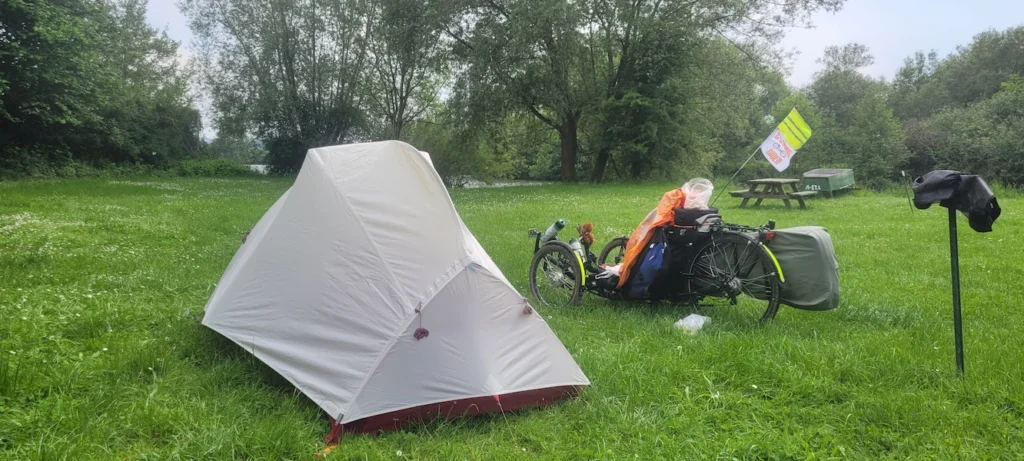
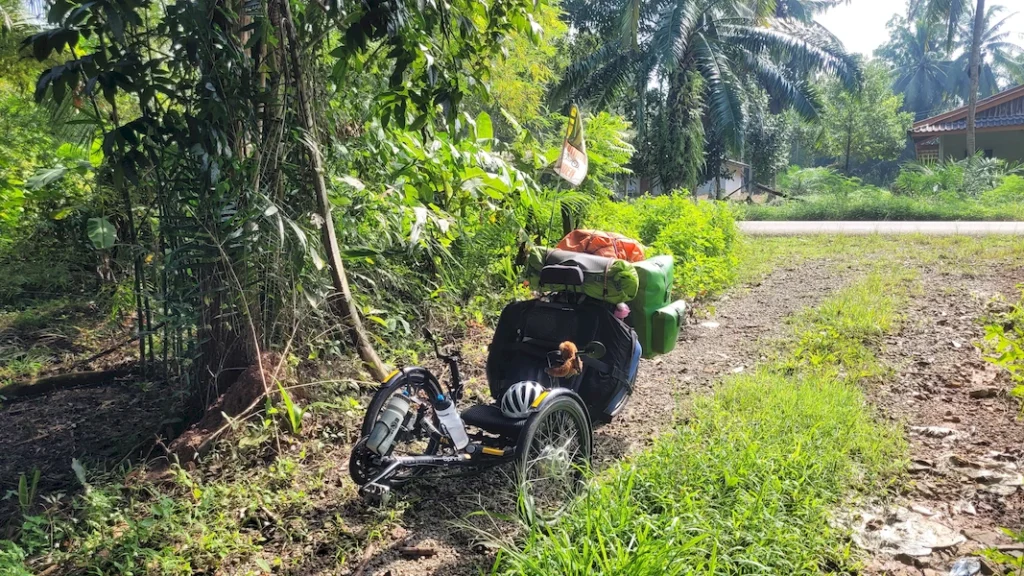
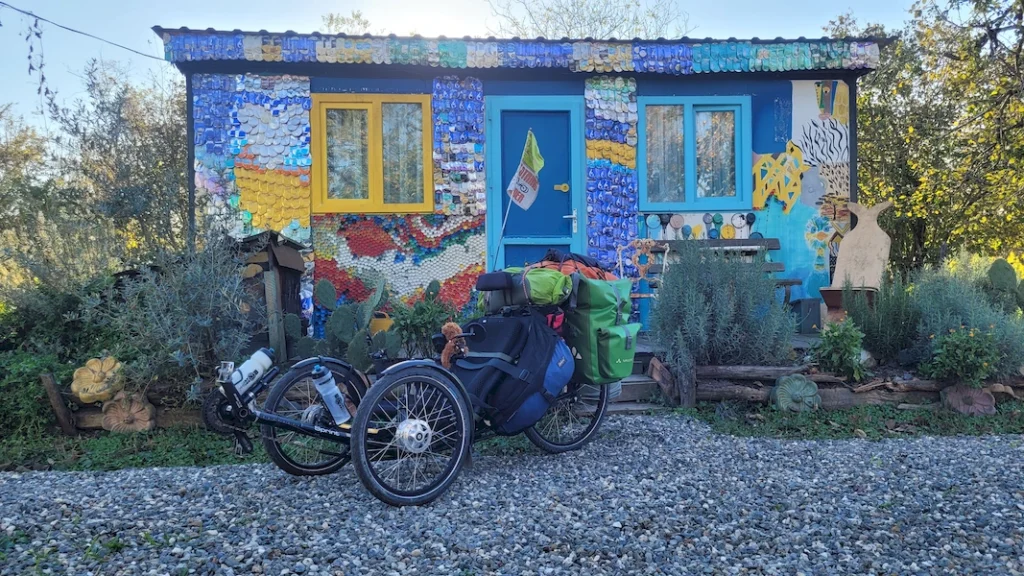
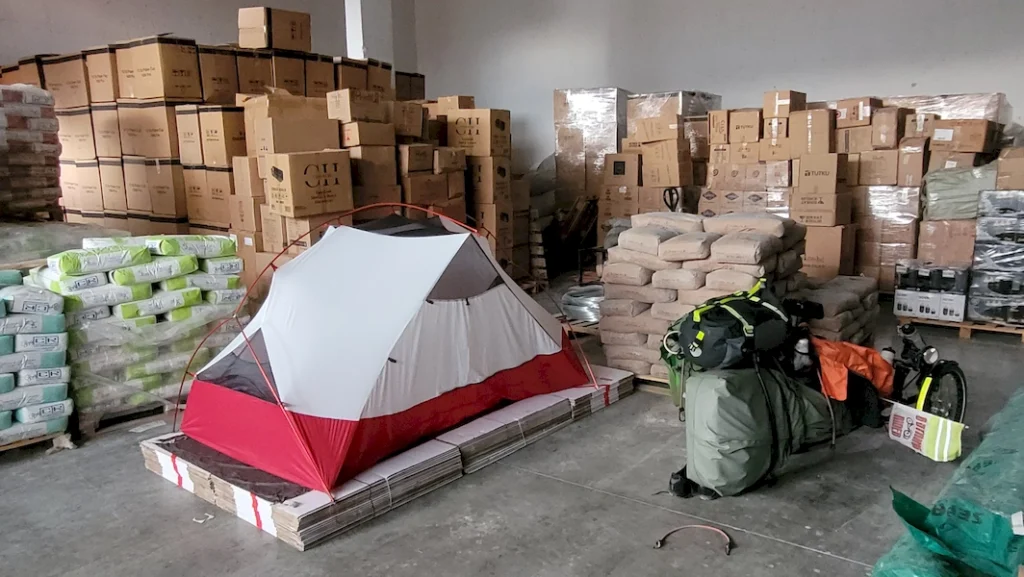

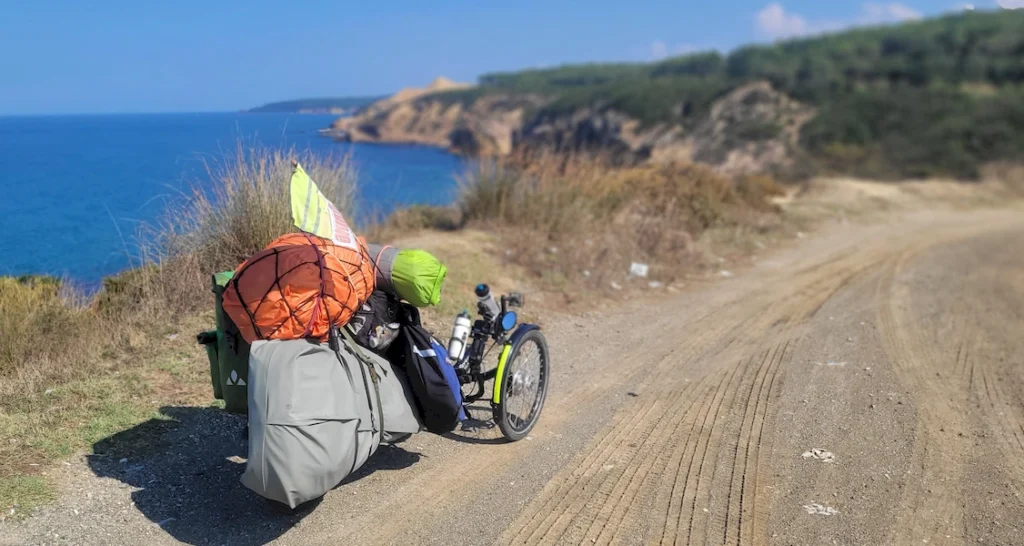
Tell us about your trike, make/model, gearing? Did you name your trike?
My travel companion is a sleek, black Ice Sprint X trike. Before settling on her, I test-rode various Ice models and even one HP Velotechnik trike (the specific model escapes me now). The Sprint X I eventually found and purchased in England had the perfect setup for my needs: reliable Sturmey Archer drum brakes, the highly-appraised Rohloff gear hub, essential mudguards front and back, and a luggage carrier. I absolutely love the Rohloff gearing; the low maintenance is a huge plus, and shifting uphill is a dream compared to any other system I’ve used.
I’ve simply nicknamed my trike Icey – and yes, she’s definitely a ‘she’. And I have another female on board! On my left-side mirror is Lizzy, a furry sloth and my trusty ‘wing girl’. Given my preference for slow travel, she’s the ideal companion. Lizzy has quite the personality, always ‘encouraging’ me to go faster, though I know she’s just teasing. Between the two of them, Lizzy and Icey have never let me down.
Any modifications to the trike? Any big mechanical issues along the way so far? How did you overcome the issues?
I’m not sure if the trike had any modifications before I bought it second-hand in England. For my part, I put a Ventisit cushion on the mesh seat for more comfort. It’s light and really supports my body well.
The only major change I made before this trip was swap out the 32-tooth chainring that was installed at the front when I bought it. I felt I needed a smaller one to tackle very steep hills and mountains – I’m talking about gradients of 10% or more. Considering the total weight of the trike, myself, and my luggage is likely around 130 kg (I’ve never actually weighed it), having that lower gear was essential. I remember climbing Pico de Las Nieves on Gran Canaria and coming short. That mountain still haunts me.
My bike mechanic back in Belgium therefore suggested an interesting piece of kit: the Efneo GTRO 3-speed front gearbox. This essentially gives you three virtual chainrings with different ratios, all from a single physical chainring: 1:1 (equivalent to a 28T), 1:1.43 (equivalent to a 40T), and 1:1.79 (equivalent to a 50T). I had it installed and tested it for a couple of months before setting off. The shifting was incredible – I’d never felt such a smooth and direct transition of power from the pedals to the chain and the rear wheel.
Unfortunately, this smooth operation didn’t last. Just one week into my trip, disaster struck on a particularly rainy day in France. It had been drizzling since morning, and then, about 15 kilometers from Sedan, the heavens really opened. That’s when the Efneo started acting up. It began slipping, like there was a noticeable delay between putting pressure on the pedals and getting a response. Followed by grinding sounds.
Initially, I suspected the chain, but all the links seemed fine. I persevered through the rain, but then the Efneo completely locked up. Trying to pedal backward was futile. I pushed harder, and it finally released, only to seize again after just ten meters. At that point, I decided to seek shelter and hitch a ride.
The next day, I took my trike to a local bike mechanic. He admitted he’d never seen anything quite like it. After a thorough inspection, he found a broken internal part but couldn’t identify its origin. When I explained my ambitious travel plans, he strongly advised me to revert to a regular chainring setup. His reasoning was sound: standard chainrings are easily replaceable anywhere in the world, offering much greater peace of mind than constantly worrying about another Efneo breakdown.
I did contact Efneo, but their suggestion was to ship the entire unit back to them to investigate. My mechanic in Belgium echoed the advice to switch back. So, I made the decision to go back to a more conventional system. However, finding the specific 26-40 chainring I wanted, proved to be an ordeal, taking two weeks because Shimano France was out of stock. It eventually had to be shipped from Germany, which also took a considerable amount of time.
So, ever since that frustrating delay, I’ve been cycling with the 26-40 chainring setup. To be honest, I rarely use the 40T, only really engaging it on long downhill stretches or when it’s flat and I have a good tailwind. Then, as you can imagine, I really get some speed going – and Lizzy absolutely loves that!
All the while, I was gently saying to her, ‘Stop following me. I can’t adopt you.’ I should have known Georgian dogs don’t understand Dutch
What animal encounter was the most memorable?
I had just left Batumi, Georgia, and after ten kilometers, a rather long climb began. Although it was still quite early, the temperature was rising and I was starting to breaking a sweat. Throughout my travels, I had my fair share of encounters with dogs – as most cyclists know, they have a peculiar fondness for chasing us, all aggressive barks and then, eventually, a disinterest. But this day was different.
As I was slowly making my way up the incline, a stray dog came running towards me. At first, she was barking, but it quickly changed into a low growl. I spoke to her calmly and in a friendly tone, murmuring something like, ‘Such a beautiful dog.’ Because I was moving slowly uphill, she seemed to lose her intimidation, started sniffing me curiously, and then let out a short, soft howl. To my surprise, she then began walking right alongside me.
I was clearly too slow for her, so she would often run ahead, then turn her head to check if I was still following. Occasionally, she would even chase after cars approaching from behind. When we passed a house, two other dogs came running towards me, but she immediately chased them away – I had my own personal, guard dog!
Reaching the summit, I parked my trike in the shade next to a bus stop, and she promptly took shelter beside me. I had a snack and shared a piece of my protein bar with her, a well-deserved treat. She gave it a hesitant sniff, took a small bite, and then spat it out. Only to pick it up again and begin chewing again, smacking loudly as the gooey bar stuck to her teeth.
Break time over, we started our descent. I was soon cruising over 45 km/h, and I figured I had finally dropped her. The downhill stretch was more than two kilometers long, so I felt a mix of sadness and relief. Sad because this stray clearly seemed to be seeking companionship, but relieved because I didn’t want her to exhaust herself trying to keep up. I kept pedaling, but then, suddenly, there she was again, appearing in the grassy shoulder right next to me – a sneaky and determined girl!
After another five kilometers of this cycling-and-running tandem, it was clear she was tiring. Her tongue was sticking out of her mouth, coated in thick saliva. I stopped for a drink and poured some water into a cup, which she eagerly gobbled down. All the while, I was gently saying to her, ‘Stop following me. I can’t adopt you.’ I should have known Georgian dogs don’t understand Dutch because as soon as I set off again, she continued her pursuit. The road was a false flat downhill, so every now and then I’d pick up enough speed to lose her, but she always reappeared.
As traffic began to thicken, I started to worry about her safety, though I also knew she was likely familiar with these roads, perhaps making my concerns somewhat unfounded. After more than fifteen kilometers together, we reached the outskirts of a city, and suddenly, she stopped. I looked back and saw her walking slowly towards me, obviously saying goodbye. This was her limit. I gave her a gentle pet on the head and thanked her for her unexpected protection. ‘Good girl!’ As I continued on my way, I saw in my mirrors that she was wandering off into some bushes, probably seeking a well-deserved nap.
The entire day, this encounter stayed with me. I love cats and dogs dearly and have even considered bringing one along on my travels, but I know that would significantly limit my freedom and my ability to roam freely. Besides, as wonderful as she was, one furry animal on this trip is probably enough.
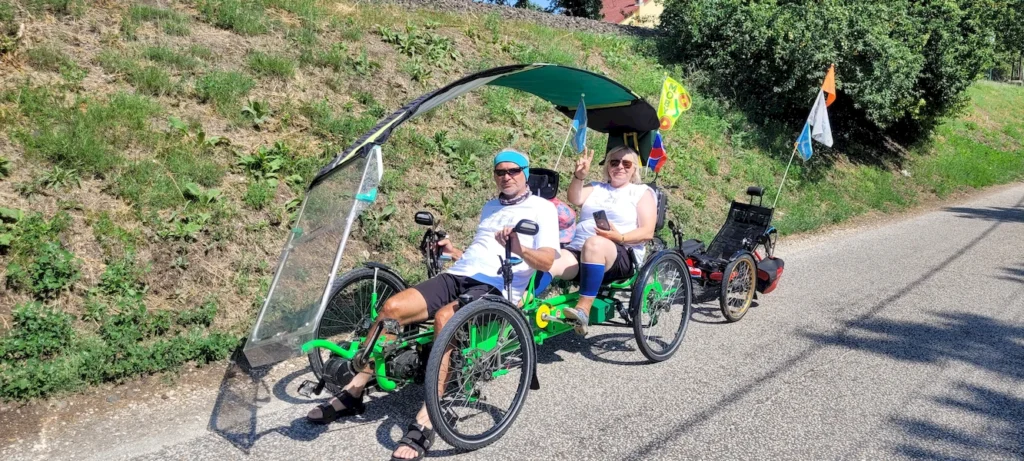
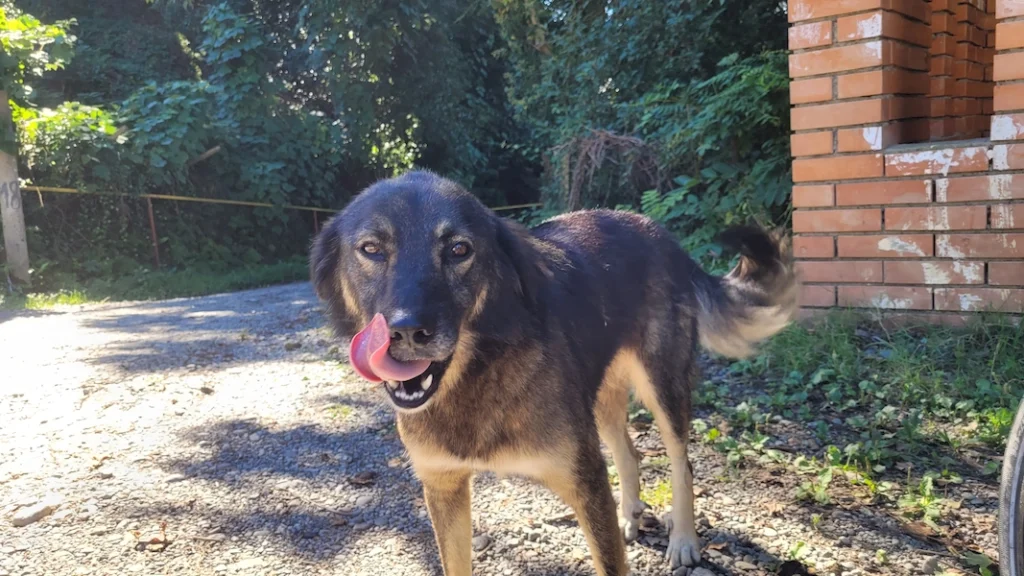

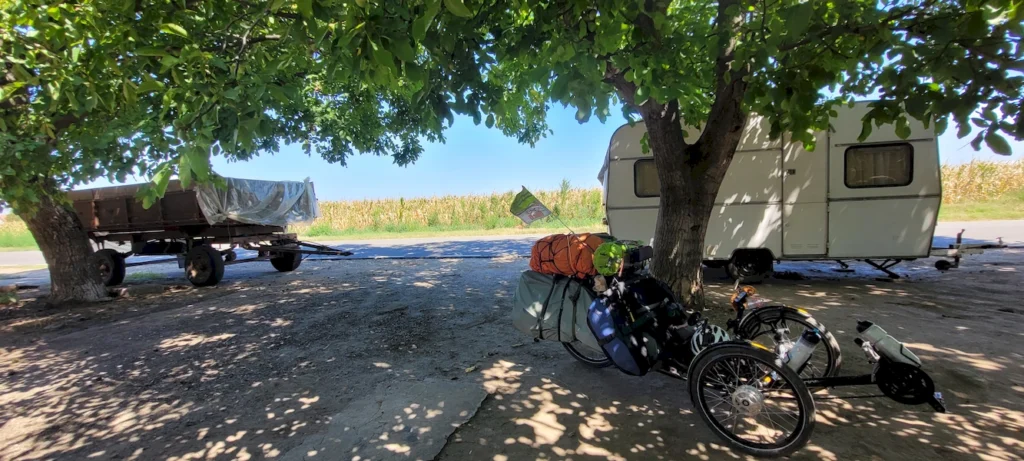
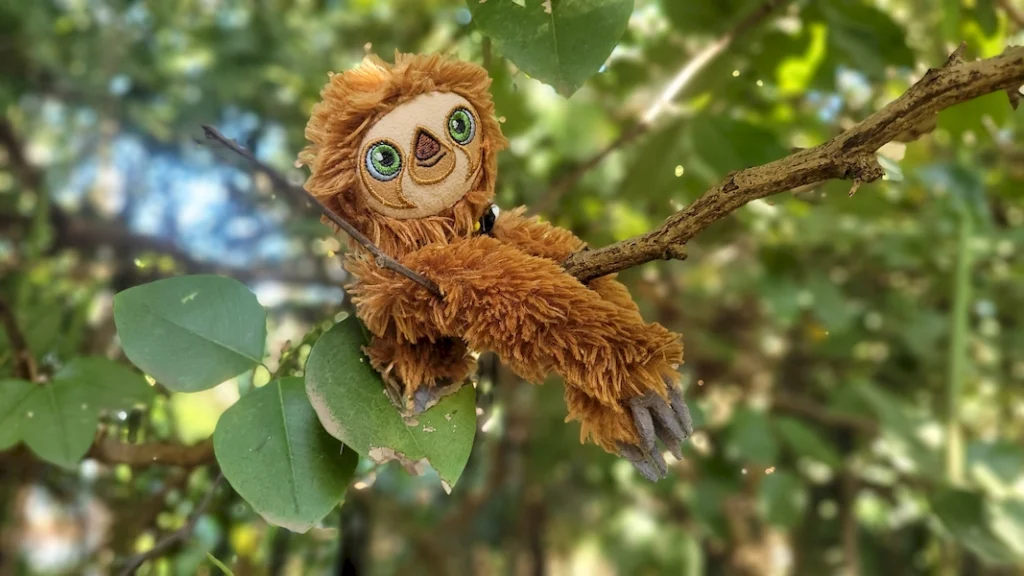
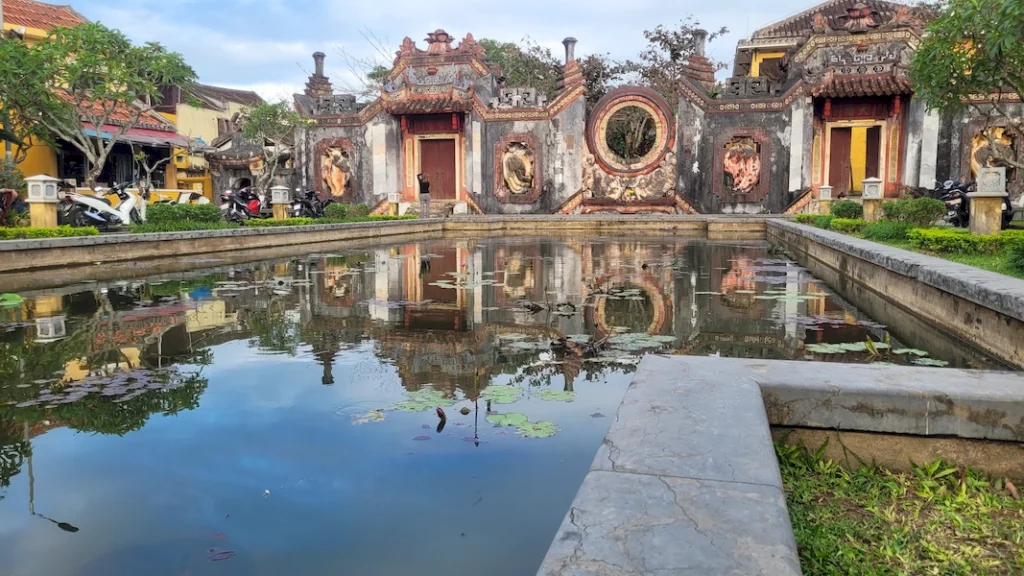
What have you learned about yourself while on tour?
That’s a deeply introspective question, and reflecting on this tour compared to my previous one five years ago, several key areas of personal growth come to mind.
Firstly, I’ve definitely become more self-reliant and confident in my own abilities. Having the experience of a previous long journey under my belt, I now trust my gut instincts more readily and have discovered a certain resourcefulness within myself to handle unexpected situations. And when I do need help, I’m no longer hesitant to ask for it.
One of the most significant shifts has been my perspective on things not going according to plan. I’ve learned dwelling on setbacks or getting overly upset when things go awry are a waste of energy. In the past, incidents like a near miss with a vehicle, could have put me in a foul mood for hours. Now, I still get upset at first (and rightly so!), but I can set it consciously aside, while taking in the beauty of my surroundings, and feeling those negative thoughts dissipate.
I also feel I’ve opened up more socially. I’m not a shy person, but I wouldn’t describe myself as an extrovert either. These days, I’ve become more comfortable initiating conversations. In the past, I often hesitated, not wanting to feel like I was ‘bothering’ people. Now, a simple ‘hello’ often leads to unexpected and enriching chats. It’s a small change, but one I appreciate.
The slower pace of traveling by recumbent trike has also profoundly impacted my appreciation for time and provided ample opportunities for reflection. It’s a different rhythm of life, one that encourages contemplation.
Of course, there are still areas for growth. I’m still working on not constantly worrying about finding a decent place to sleep or fretting too much about my budget. However, I’m definitely not in the same headspace as years ago, where I would come up with all sorts of worst-case scenarios – mechanical breakdowns in the middle of nowhere, difficult border crossings, or the dreaded thought of my trike being stolen. I’ve learned to address issues as they arise, which brings a significant sense of inner peace. Naturally, being human, this isn’t always a perfect process, but it’s a definite improvement.
Speaking of the ‘what if my bike gets stolen?’ question – someone did ask me that at the beginning of this adventure. My answer remains twofold:
A) I don’t think the thief will have much fun cycling my fully loaded trike uphill.
B) If the worst happens, I’ll acquire a backpack, and a mule, and a dog! And together we’ll continue this journey on foot. There’s always a way forward. That’s perhaps the biggest and most reassuring lesson I’ve learned throughout my travels. And ultimately, if everything truly goes sideways, there’s always the option of going home. That’s a privilege I recognize and am grateful for. But until that day, I’ll continue riding on my trike, thank you for asking!
I felt a strange mix of pride, awkwardness, and embarrassment. I’m not sure if fame is really for me, but hey, it certainly made for an interesting few days on the road!
Tell us about your best day touring on a recumbent.
Oh, that’s a tough one to pick, but if I had to choose, I’d say my third day in Vietnam really stands out. It began with a rather abrupt wake-up call – the booming bass of early morning karaoke! Vietnamese have a real passion for it, and they like it loud! After packing up, I found a peaceful spot for breakfast and then set off, my sights set on the vast Mekong Delta. It’s such an expansive network of waterways that it often felt like I was constantly cycling parallel to canals and smaller branches of the mighty river.
The roads alongside these canals are often busy and quite straight, which could be a bit boring. Still, I’d encountered worse, and I needed to stay focused as I was still getting to grips with the local traffic flow.
My interactions with scooters, in particular, were a bit nerve-wracking. They have a habit of pulling out without much warning, eyes fixed straight ahead. I actually gave one rider quite a fright when I unexpectedly appeared alongside him on a downhill – I was going a fair bit faster than he was! He swerved dramatically to the right, nearly ending up in the ditch. Later, when he overtook me, he didn’t even glance my way!
As I rolled into a small village, school had just finished, and the streets were suddenly alive with kids on bicycles and e-scooters. Almost all of them waved, and some even cycled alongside me, firing off the standard greetings: ‘What’s your name?’ ‘Where are you from?’ Most of the time, they didn’t even wait for my reply before speeding off with giggles – a little test, I think, to see who was brave enough to interact with this strange foreigner.
Lunch time arrived and I found a roadside restaurant. The only vegetarian option was a simple dish of rice with cabbage and onion broth. When I had finished, the kind waitress brought me a second helping, which I certainly didn’t refuse!
You often find these places in Southeast Asia have those tiny plastic chairs, which aren’t the most comfortable for someone with long legs like me – my knees practically end up by my ears! However, some of them come with a fantastic bonus: hammocks. Luckily, a couple were free that day, so I decided to indulge in a siesta before continuing. I ordered an iced tea, got comfortable, and drifted off. Every restaurant should have this! When I went to pay for my food and drink, the waitress made an ‘X’ with her arms – a free lunch! I thanked her warmly and then made my way to a homestay in Long Xuyên.
After checking in, I went for a walk. Suddenly four young boys came running towards me, shouting excitedly, ‘Mister, mister, we want to invite you to join our English lesson!’ I was taken aback. I looked down the street and saw their teacher gesturing for me to come over. “Well, why not”, I thought. Mrs. Tran welcomed me into her classroom. The children were buzzing with excitement that this skinny, sun-kissed Westerner was joining them.
Twenty bright-eyed eleven-year-olds stared at me as I introduced myself, shared stories of my travels, showed them some pictures, and answered their many questions. Mrs. Tran explained that some of them had never seen a foreigner before, and she often invited travelers to speak with her students to expose them to different English accents and customs. They gave me fruit and snacks, little souvenirs, and one sweet girl even did a sketch of me. It was truly heartwarming.
As I was leaving, Mrs. Tran asked if I’d be willing to join another lesson the following morning. I had planned a rest day, but I couldn’t say no. The next day followed the same wonderful pattern: enthusiastic kids, a barrage of questions, more treats, songs, and lots of laughter. It was such an incredible and welcoming introduction to Vietnam!

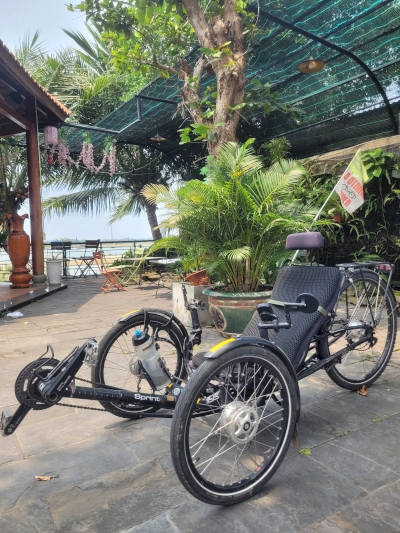
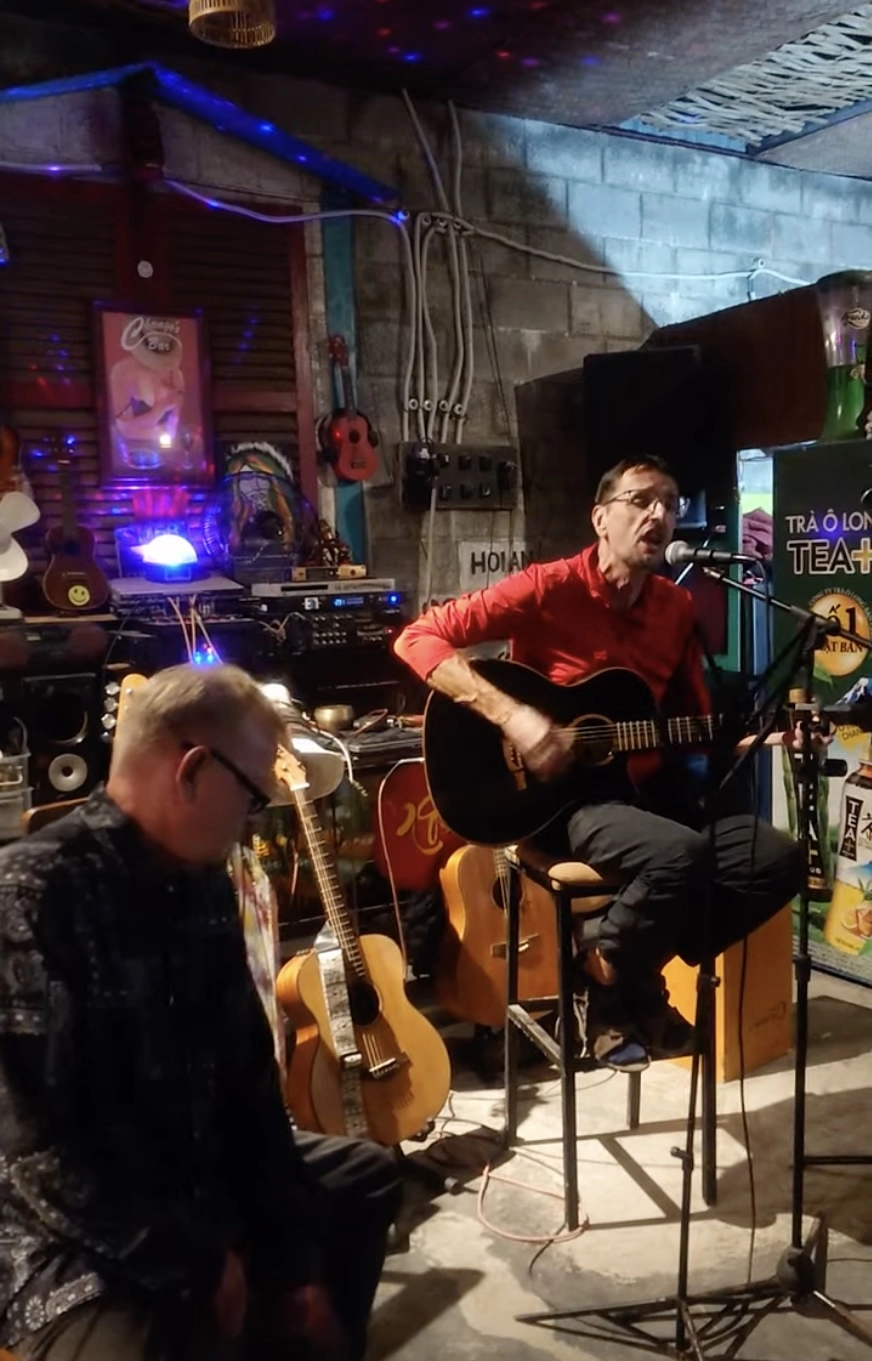
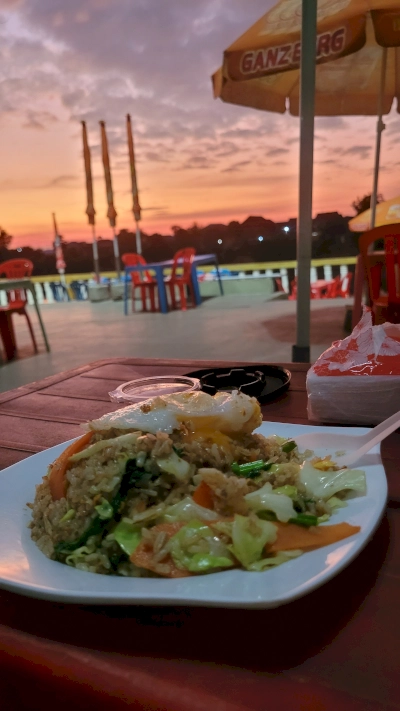
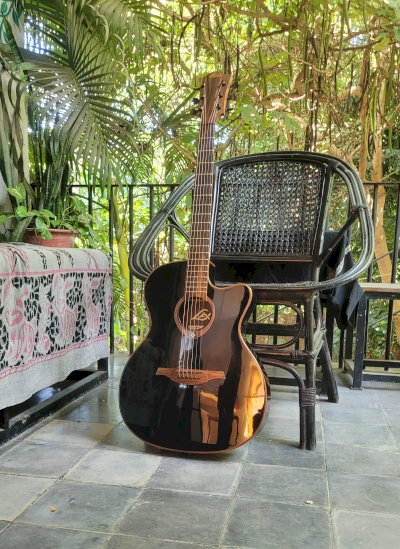
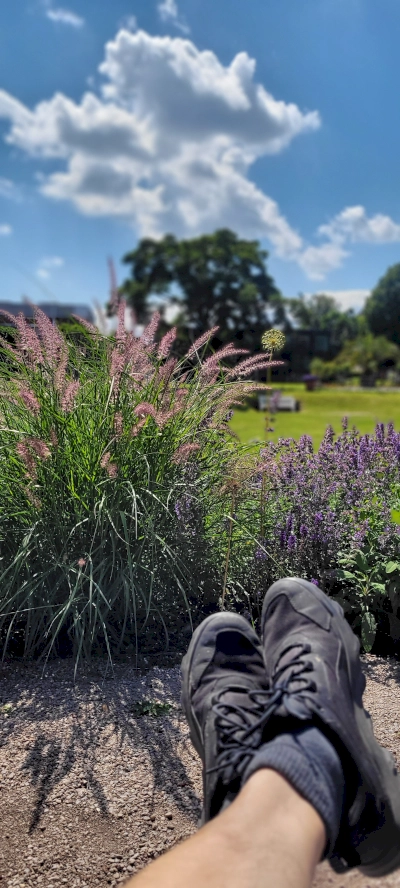
Tell us about your most challenging day touring.
One of my most challenging days on tour unfolded in Bulgaria, shortly after I left the Black Sea coastline and headed inland. I’d spent the previous night in a small village and made sure to get an early start, hoping to outpace the summer heat for a few hours. The entire summer had been one long heatwave, with temperatures consistently above 35°C. Today promised to be no different, with an added 20-kilometer climb. I knew the gradient wasn’t very steep but I was worried about taking this scenic route, because Bulgaria’s secondary roads are often in poor condition. My optimistic calculation for the day was around 65-70 kilometers.
The initial part of this stage led me through a forest, offering shade against the already blistering sun. The road was narrow, with cracks across its surface, but still manageable. The gradient gradually increased, but my legs were pushing steadily. The main annoyance at this point was the relentless swarm of tiny flies that buzzed around my sweaty head. I even resorted to removing the cap from under my helmet and waving it around like a madman – must have been a comical sight to watch.
After more than three hours of grinding uphill at a mere 6 km/h, I finally reached the summit. I had lunch in the park of a small village, where I drew the curious attention of some local municipality workers who came to inspect this strange traveler and his even stranger vehicle. Unfortunately, our communication was limited by the language barrier, as my Bulgarian is somewhat non-existent.
After all the hard work uphill, I was looking forward to a glorious descent. Alas, my hopes were squashed by heavy machinery ripping up half the road. For a stretch of 12 kilometers the road surface was turned into a war zone. Smooth asphalt gave way to loose gravel and thick dust, which then morphed into stretches of small, jarring boulders, and finally, sheer, unforgiving rocks. A quick downhill cruise was impossible this way. In fact, I was moving even slower than I had been going uphill!
At times, the surface was so wildly uneven that I nearly lost my balance and had to put a foot down to avoid a tumble. Finally, my ordeal ended but it was well past 3 PM, and I still had a significant 40 kilometers to cover. I could feel a tailwind picking up and the road surface was smooth. It seemed things were finally looking up. But my optimism was short-lived.
As I continued, the road conditions worsened yet again. At one point, a car approaching from the opposite direction stopped beside me. The driver sighed, shaking his head, ‘Don’t go any further. It’s impossible even with a car.’ This was shaping up to be a truly disastrous day. I now had to find an alternative route or, failing that, a place to sleep soon. And to make matters worse, I was running out of water.
Spotting no houses in sight, I desperately started looking for a gas station, which Google Maps indicated was still ten kilometers ahead in my current direction. By this point, my irritation was reaching its peak. I was fed up with the terrible roads in Bulgaria.
When I arrived at the gas station, I refilled my water bottles and treated myself to a much-needed ice cream. Fueled up, I pressed on, but the fatigue was taking its toll, and that’s when mistakes happen. I missed a crucial turn! Another ten kilometers added to the already punishing day. Why not? My legs were burning, and even my backside, usually quite resilient, was now in agony – a truly rare occurrence.
Then, finally, a stroke of luck! I hit a main road: smooth, glorious asphalt and false flat. By 6 PM, utterly drained, I rolled into the city of Elhovo, having covered 95 kilometers. A warm shower and a hot meal did little to revive my depleted energy. The next day was a non-negotiable rest day.
Did you plan your route before departure? How do you decide where to ride?
I’m definitely not one for rigid, long-term plans. Any seasoned traveler knows that unexpected events will occur. You learn to be adaptable and let go of fixed ideas pretty quickly. I always have a general direction or a final destination in mind for a leg of the journey – for example, the first part of this trip was aiming for Istanbul, with the initial thought of following the EuroVelo 6 for its mostly flat terrain. From there, my planning usually extends about three to four days ahead, often followed by a rest day to recover.
My primary planning tools are mainly Komoot, Google Maps, and Google Street View. I use Street View for reconnaissance. It allows me to check if a road has a shoulder or emergency lane, assess the quality of the asphalt, or even confirm if a marked ‘street’ isn’t just a rough dirt track. Once I’ve mapped out a few stages, I transfer them to my Garmin for daily navigation. This approach has worked really well for me so far.
I do try to prioritize scenic routes whenever possible, although that’s not always the most practical choice. While they’re often safer and quieter, venturing too far off the beaten path can isolate you from resources. Running out of water or facing a mechanical issue in a remote area can become a significant problem, potentially leading to long waits for another person to pass by.*And let’s be honest, tackling off-road terrain with a fully loaded trike isn’t always a joy. Not only is it wider, which can be a real issue with dense vegetation – I’m not a fan of getting whipped in the face by thorny branches.
I’ve even jokingly considered attaching blades to my front wheels to trim the verges as I go! Could be a great side hustle. All kidding aside, going off-road is generally slower, and I don’t always find it the most enjoyable, especially when faced with an uphill gravel track where my back wheel just keeps spinning.
So, it’s a constant calculation. You can’t always predict the road conditions until you’re actually there. That’s when I make the call: do I push through a bad shortcut, or opt for a longer, easier detour? Weather and traffic also play a significant role in on-the-fly route adjustments. If I feel unsafe on a main road, I’ll look for an alternative.
In Turkey, for instance, there were some long, quite dangerous tunnels, and I made a point of avoiding them by going around or over. Usually, that meant an extra 5-10 kilometers or some uphill climbing, but I don’t think it’s worth taking the risk. It’s not a race, after all. And often, those scenic detours offer the most rewarding views.
Looking ahead, I’m actually considering planning even less and seeing where the road takes me. I met a French cyclist who travels without any GPS or even maps! That’s adventure in its purest form. I’m not sure if I’m quite ready for that level of spontaneity, but it’s definitely something I’ve been pondering.
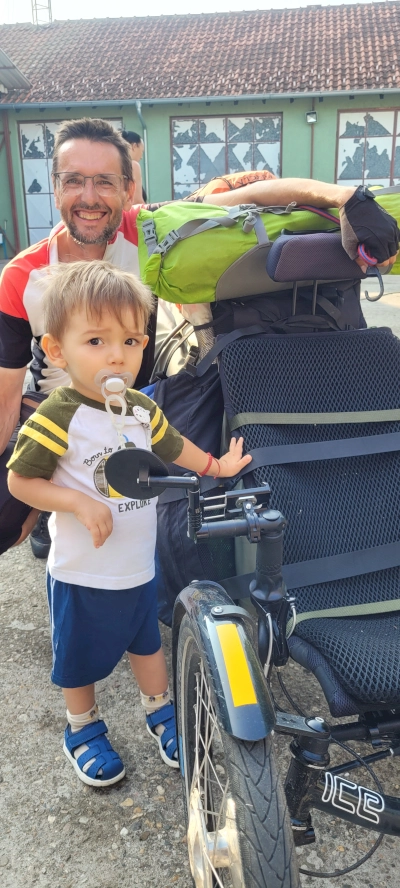
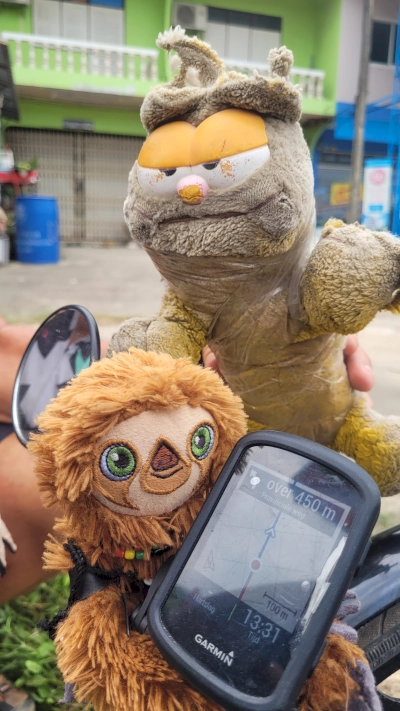
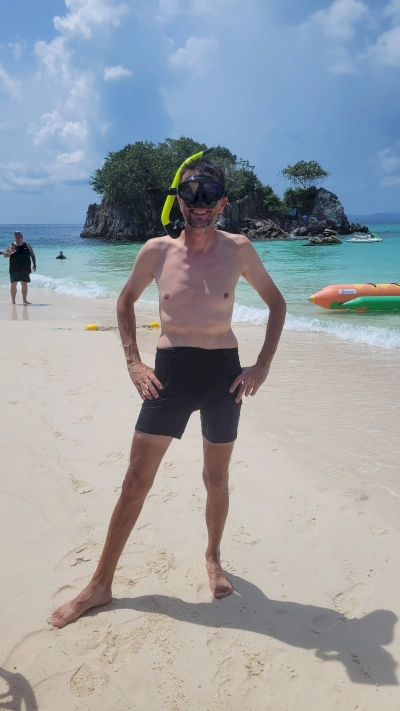
Where are you currently, and what places are you going to next?
Right now, I’m enjoying the peaceful coastal village of An Bang, which is about twenty kilometers south of Da Nang. I actually chose this spot randomly, and it’s turned out to be a real hub for music. There’s an open mic night here every night, so I’ve had plenty of chances to perform and connect with a wonderful local music community. I arrived at the end of February and plan to stay until the beginning of July. The weather will shift significantly after that, becoming very hot and humid.
Next up, I’d like to go to South America, likely Chile, Argentina, or Peru. I’m aware that it will be winter there at that time of year, and the mountains could be quite challenging on a trike. So, my current thinking is to either find a central location to use as a base, exploring the country with lighter loads while leaving the bulk of my gear in a temporary storage spot, or I might even set my trike aside for a while to explore on foot or using other modes of transport. Nothing is set in stone yet.
After South America, I’d love to head to Africa. I spent a significant amount of time in South Africa many years ago, and I always had this idea of making my way back home on a motorcycle. However, due to my back issues, that’s not an option. So, why not do it on my trike? Ambitious? Definitely, but I’ve encountered people undertaking even more audacious journeys!
I’ve been thinking of creating podcasts on the local music scene here in An Bang, featuring the many fascinating stories of the musicians I’ve met
You are a vegetarian, was it difficult to get good food in some places? What places had the best food?
Being a vegetarian has definitely presented its challenges in many of the countries I’ve traveled through. In Belgium, France, and Germany, finding vegetarian options or ingredients in restaurants and supermarkets was generally straightforward. However, as I ventured further, it often became more of a problem.
I make it a point to cook for myself three to four times a week while on the road, which gives me complete control over my meals. But when I do eat out for lunch or dinner, it’s been quite hit or miss. I’ve encountered waiters in almost every country I’ve been in, who looked utterly bewildered when I explained that I don’t eat meat or fish, and even restaurant owners who turned me away entirely. I was particularly surprised that in countries like Thailand, it was sometimes difficult to convey that I simply wanted rice or noodles with vegetables.
Even with the help of Google Translate, the concept didn’t always seem to register. It’s also interesting how the understanding of ‘vegetables’ varies across cultures. Take soy shoots and tomatoes, for example. Strictly speaking, they aren’t vegetables, but they are part of my diet. Even when I showed a chef these items as examples of what I wanted, he still couldn’t grasp my request for ‘vegetables’. Pretty frustrating. I ended up taking pictures of dishes that I could eat to show future restaurant staff what I was looking for. And even then, I still faced rejections.
So, often it took considerable time and effort to find suitable food. In Cambodia, I once cycled for hours without any food in sight and when I finally stopped at a roadside restaurant, the only thing they had was rice and pork. I decided to order two large portions of plain rice with sugar. Getting my calories in. On another occasion, I pulled out a can of baked beans in tomato sauce and asked the cook if he could heat it up for me.
That being said, I’ve also had some truly exceptional vegetarian meals, particularly in Georgia and Vietnam. In Georgia, I camped in a small vineyard owned by a lovely middle-aged couple. Sergei, a former surgeon who followed his passion for winemaking, and his wife Maria, who managed their hospitality. That evening, Maria prepared a vegetarian feast for me, including grilled eggplants, stuffed potatoes, local cheese, asparagus, lentils, grapes, and dates. Sergei generously poured me three glasses of his homemade wine. I truly felt like a king.
Later in Vietnam, I stayed in a small town where the only vegetarian/vegan restaurant was located in a municipal building. When I walked in, everyone stared – I definitely stood out. One of the waitresses showed me to the buffet, which was an incredible display of countless dishes, most of which were completely unfamiliar to me.
Since no one spoke English, I had no idea what I was ordering or eating! I did recognize some fresh spring rolls and grilled tofu, and of course, many of the vegetables, but there was so much food I had never seen before. The best part? It was an all-you-can-eat buffet! I went back for three servings and only paid the equivalent of 8 euros, including a drink!
In contrast, in Bangkok, I had one of the best vegan bowls I’ve ever tasted. It was packed with quinoa, avocado, turnips, green beans, and beetroot hummus, but it was the incredible seasoning – a complex blend of spice, bitterness, sweetness, and a rich aftertaste – that made my taste buds sing. However, it came with a hefty price tag of 18 euros, still reasonable compared to Europe.
Here in An Bang, where I’m currently based, I have the wonderful opportunity to cook for myself, which is a welcome change from the often simple veggie rice dishes offered by the local restaurants. Nothing quite beats my own homemade tomato sauce and vegan chocolate mousse made with chickpea liquid!
Any challenges crossing borders?
Border crossings generally haven’t been too problematic, although I certainly attract a lot of attention! Most customs officers have been friendly and curious. The only border crossing that really frustrated me was the one from Turkey into Georgia. It was quite chaotic on the Georgian side.
I had actually taken a bus from Rize in Turkey to the border because the traffic along the Black Sea coast was incredibly dangerous, with trucks and buses speeding through tunnels. The plan was to unload my trike on the Turkish side of the border, get across, and then reload everything onto the connecting bus that would take me to Batumi. I had already paid for this entire journey, and the driver had assured me he would meet me just past the Georgian customs.
A Turkish customs officer directed me inside a building for my exit passport stamp. The catch was, the office was on the first floor, and the elevator was out of order. I was reluctant to leave my trike unattended outside, but there was absolutely no way I could get it up the escalator leading to the office. As I was trying to figure out what to do, a helpful local suggested a simple solution: why not go through the car checkpoint? It was so obvious, I wondered why I hadn’t thought of it myself!
I got my exit stamp, went to the Georgian side, and cycled to a bustling square filled with cars, buses, restaurants, tourists lugging their luggage, taxi drivers hustling for fares, and police officers shouting as they tried to manage the constant flow of people. I found myself in the middle of all this commotion, just observing and trying not to get swept away by the tourist traffic.
The bus driver appeared when a taxi driver approached me, asking what I was doing and where I was headed. I explained that I had already paid for a ride to Batumi, and he just burst out laughing. ‘You’ve been scammed,’ he said. ‘He’s never going to come.’ I didn’t want to believe him, but as time went on, my confidence started to waver. The taxi driver had clearly seen this happen before and would occasionally point at me and chuckle with his colleagues.
Eventually, he came over and presented my options: either pay him another 25 euros to drive me to Batumi or cycle there myself. It had been raining for the past three days, and the sky was still overcast. It was getting late, and Batumi was still 25 kilometers away. The thought of having to pay extra on top of the already expensive bus ticket really annoyed me, so I thanked him and said I’d cycle. After waiting for another two hours, I finally plunged into the chaotic Georgian traffic, where what looked like two lanes were somehow accommodating four cars!
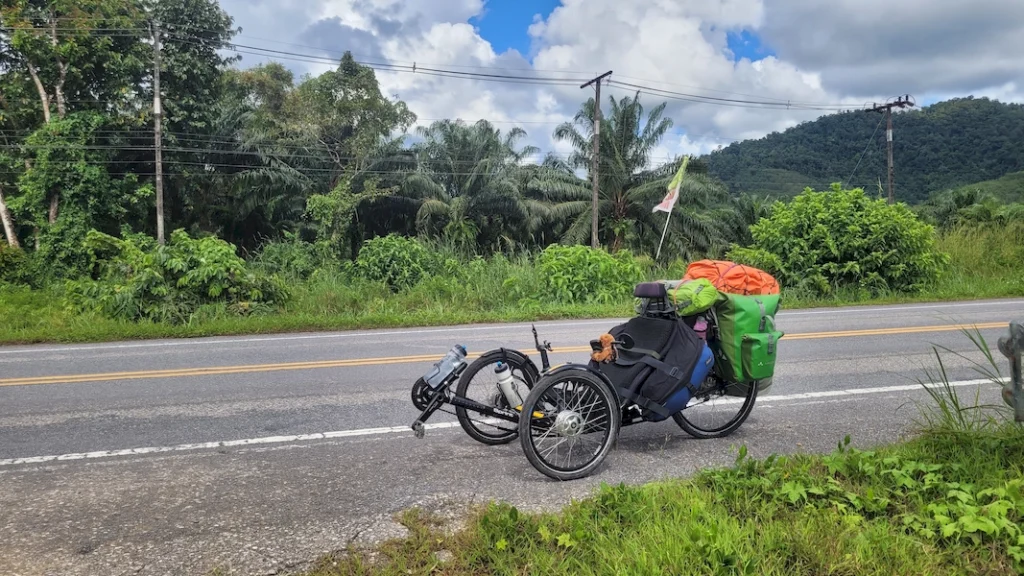
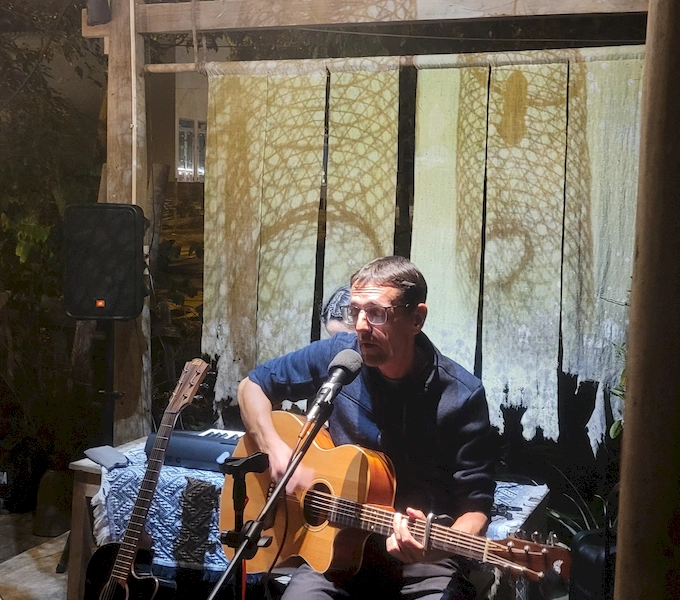
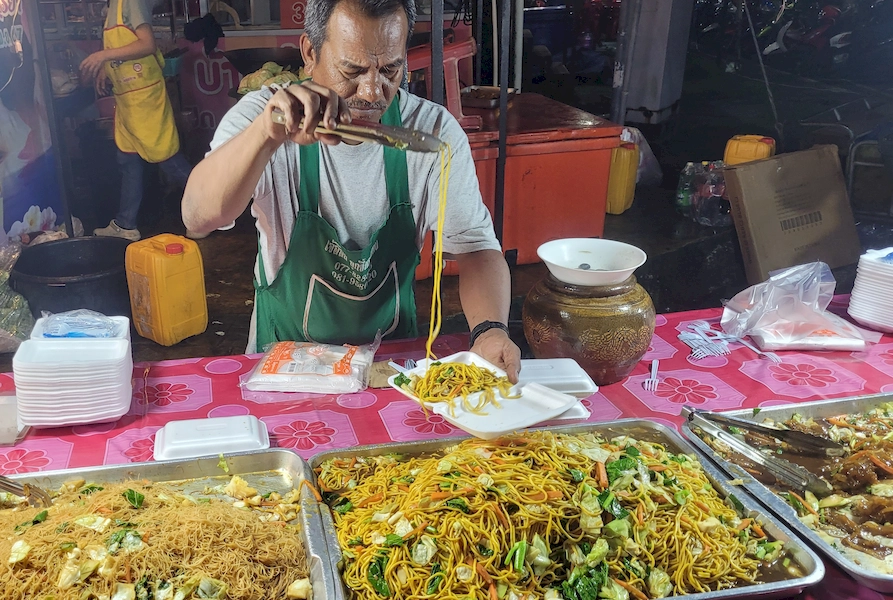

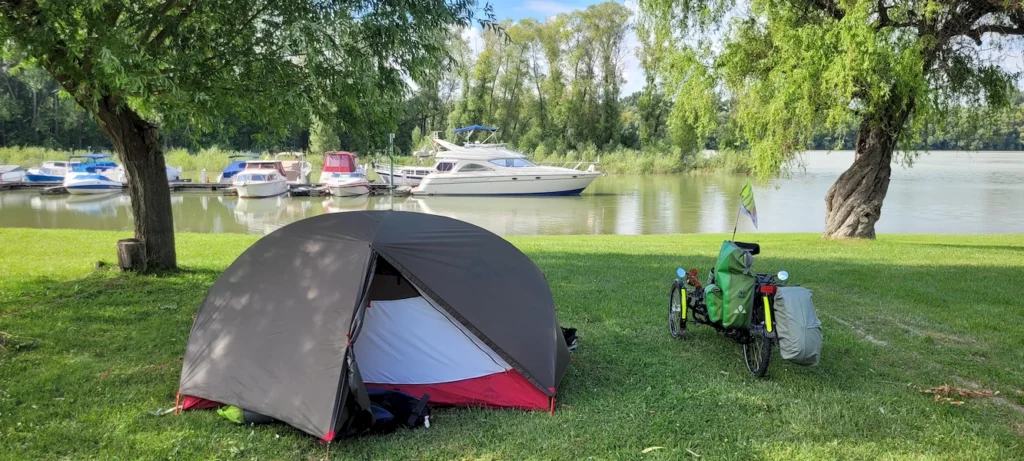
Riding a trike can make one feel like a celebrity, people taking pictures and asking questions, what was one of your best encounters with locals?
I definitely had my fifteen minutes of fame in Turkey! I had just arrived in Düzce, a lively city in the north, nestled between Izmir and Bolu. My Warm showers host greeted me and took me to my accommodation, which was a unique place – a restaurant and horse riding school owned by a gentleman named Murat. He treated me to some delicious local dishes and we chatted about my travels. Later, we were joined by a well-known local comedian and two journalists, which was quite unexpected – I certainly wasn’t anticipating an interview!
After setting up my tent, we prepared for the interview. Murat kindly offered to translate the journalists’ questions, and the whole thing was being recorded. The comedian was also very engaging and even wanted to try riding my trike, but he was too short to reach the pedals, so he simply sat on it, beaming for the camera. Later, I even performed a Belgian song, and we wrapped up the filming with a shot of me getting into my tent. It was a truly bizarre but memorable experience.
The interview was subsequently published on Facebook and some local news outlets. Then, just three days later, I was waiting at a traffic light when a young man approached me. He flashed his reporter badge and asked if I was Henk from Belgium. He requested permission to take some photos and conduct another quick interview, which I agreed to. My story was then featured again on the website of his media outlet.
My Instagram account saw more likes than ever before! And in the following days, people would drive past me, calling out that they had seen me on Facebook. I felt a strange mix of pride, awkwardness, and embarrassment. I’m not sure if fame is really for me, but hey, it certainly made for an interesting few days on the road!
Any challenges with people while riding alone?
Surprisingly, I’ve had very few negative encounters with people while riding alone. Of course, there were a few instances of impatient or unfriendly drivers on the road. And I do recall one night in Bulgaria when the police woke me up while I was wild camping, even though I had received permission from other officers – it seems the message hadn’t been relayed. They were still friendly about it, though. But overall, I feel very fortunate to have had overwhelmingly positive experiences with people throughout my journey.
Aside from riding trikes and playing guitar, are you working on other projects while out adventuring?
Absolutely! Firstly, I’m documenting my travels. While my Instagram serves as a kind of visual blog, I also keep detailed notebooks – almost like logbooks – where I record distances covered, expenses, and specific highlights or observations that don’t always make it to Instagram.
Beyond that, I’ve embarked on writing a full-fledged travel book and have already completed a number of chapters. Simultaneously, I’m nearing the finish line of another book focused on taking action, drawing heavily on my personal experiences and including practical exercises to help readers understand the importance of simply starting. The working title is ‘Start Already!,’ and it’s intended to be a real-life guide to getting things done.
I’ve also accumulated hours of video footage throughout my travels, primarily documenting cycling paths – noting their locations and conditions. I’m not entirely sure yet how I’ll shape this into something engaging, but it will likely find its way onto YouTube eventually.
More recently, I’ve been thinking of creating podcasts on the local music scene here in An Bang, featuring the many fascinating stories of the musicians I’ve met. And finally, due to frequent requests, setting up a website has become another task on my ever-growing to-do list. Looking at it all, I’ll certainly have plenty to keep me occupied until I hit the road again. Oh, and I also need to brush up on my Spanish before heading to South America!
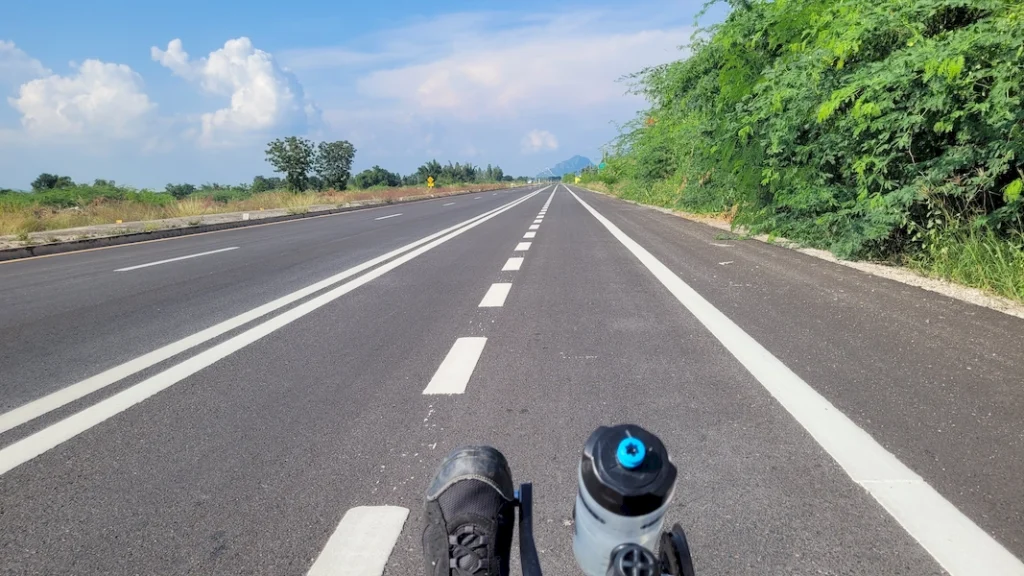
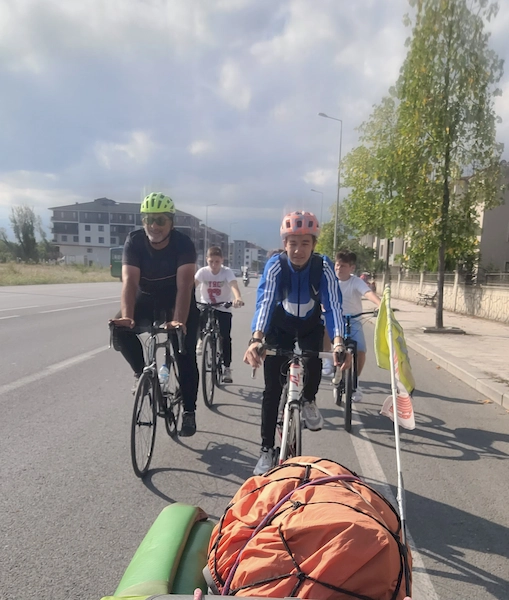
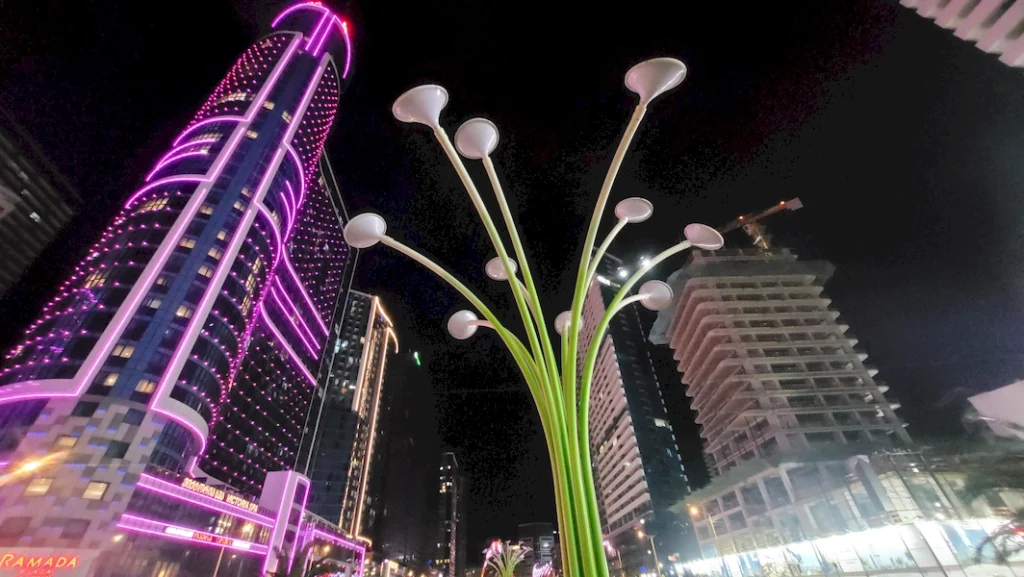
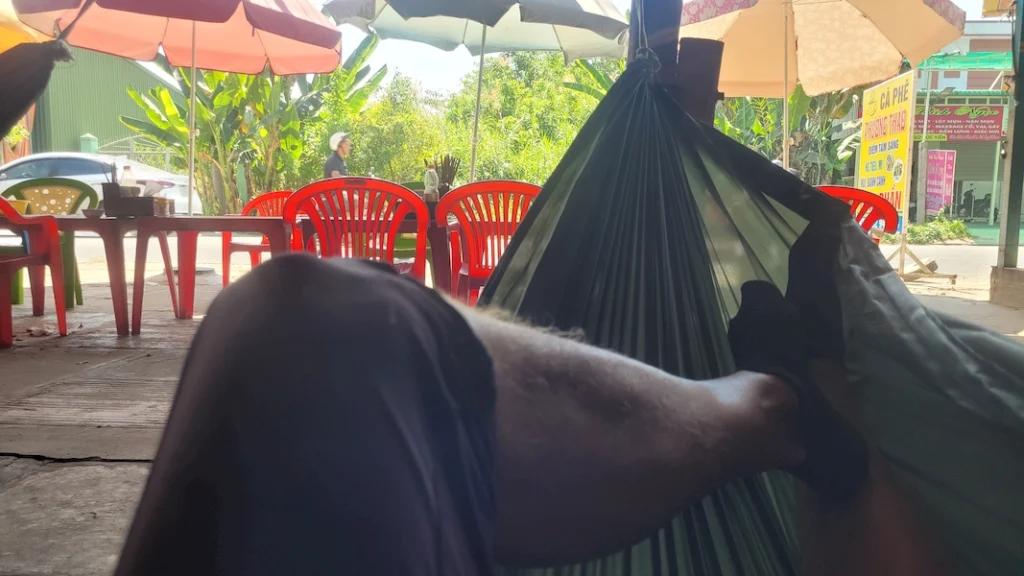
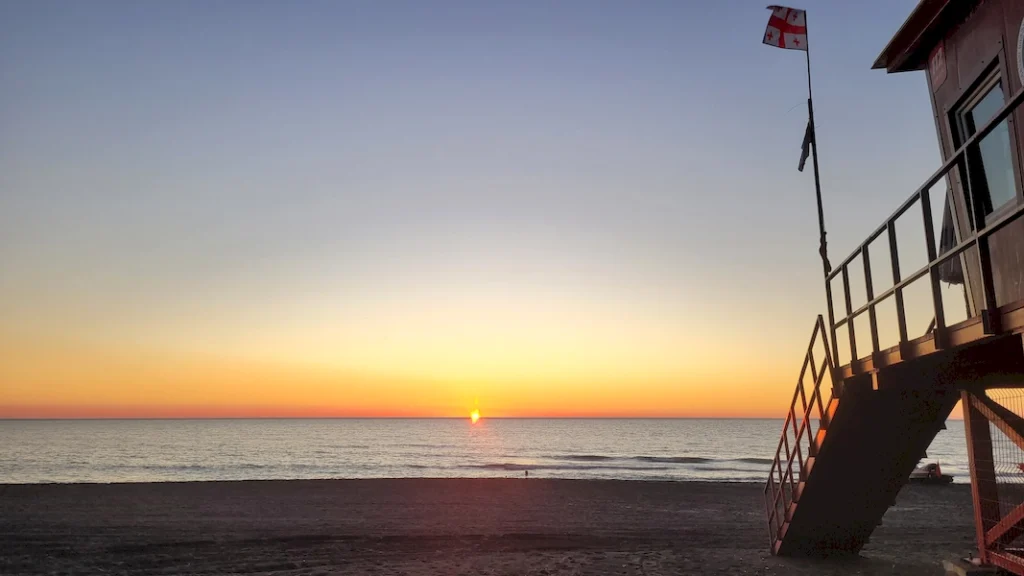
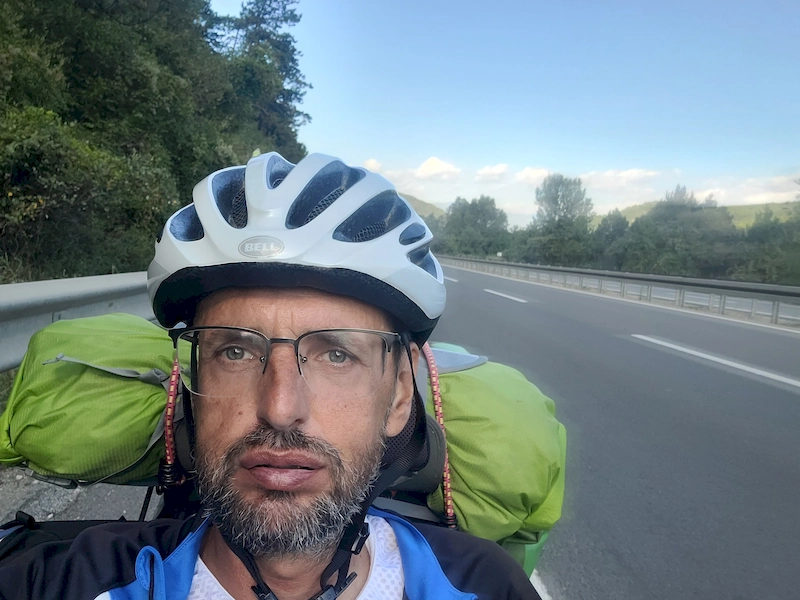
Thank you for the interview!

